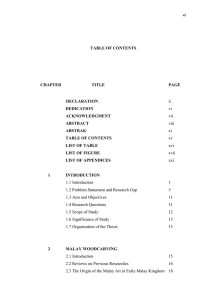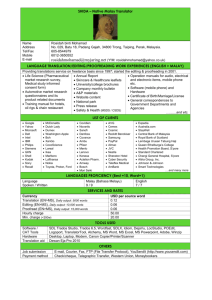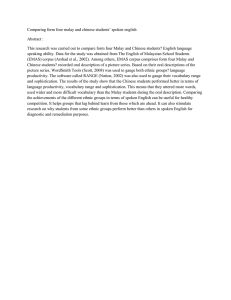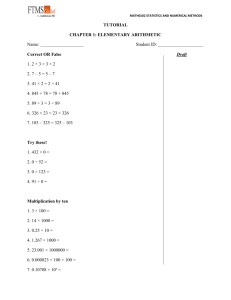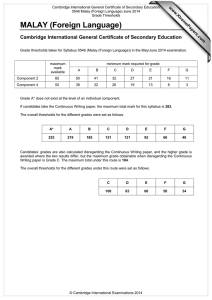1 Woodcarvings are prime determinant of a building aesthetic value.
advertisement
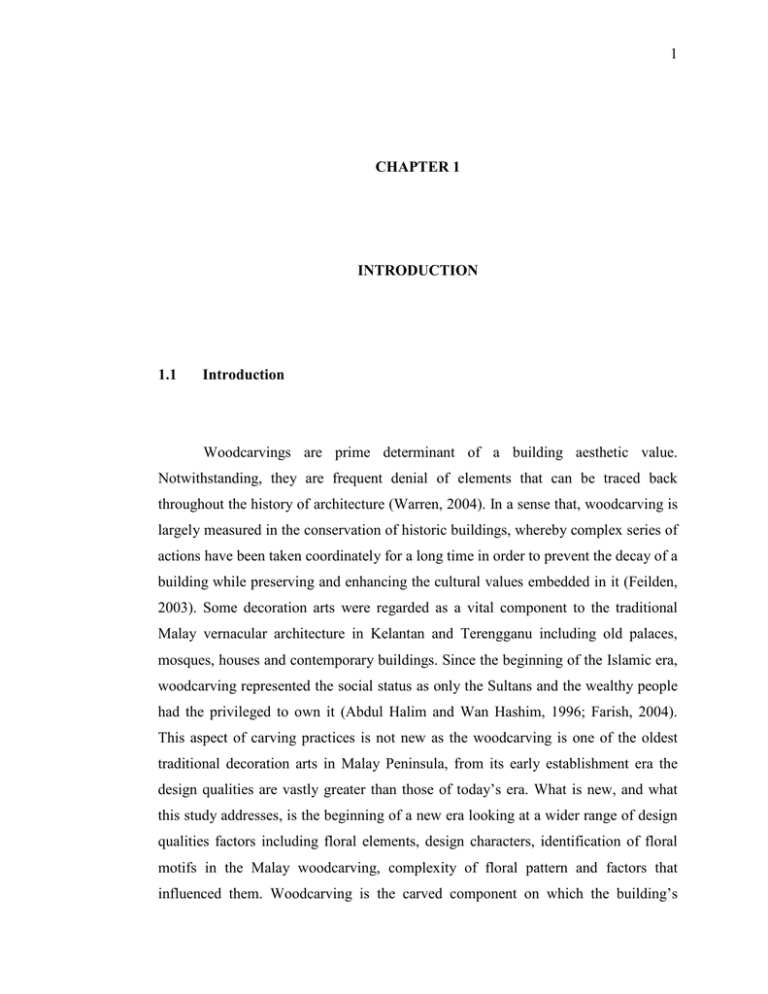
1 CHAPTER 1 INTRODUCTION 1.1 Introduction Woodcarvings are prime determinant of a building aesthetic value. Notwithstanding, they are frequent denial of elements that can be traced back throughout the history of architecture (Warren, 2004). In a sense that, woodcarving is largely measured in the conservation of historic buildings, whereby complex series of actions have been taken coordinately for a long time in order to prevent the decay of a building while preserving and enhancing the cultural values embedded in it (Feilden, 2003). Some decoration arts were regarded as a vital component to the traditional Malay vernacular architecture in Kelantan and Terengganu including old palaces, mosques, houses and contemporary buildings. Since the beginning of the Islamic era, woodcarving represented the social status as only the Sultans and the wealthy people had the privileged to own it (Abdul Halim and Wan Hashim, 1996; Farish, 2004). This aspect of carving practices is not new as the woodcarving is one of the oldest traditional decoration arts in Malay Peninsula, from its early establishment era the design qualities are vastly greater than those of today’s era. What is new, and what this study addresses, is the beginning of a new era looking at a wider range of design qualities factors including floral elements, design characters, identification of floral motifs in the Malay woodcarving, complexity of floral pattern and factors that influenced them. Woodcarving is the carved component on which the building’s 2 element is draped, with its functions and decorations. Hence, it is essential to understand the elements and its physical condition in order to properly preserve the architecture. A keen interest in the traditional art of Malay woodcarving was expressed as early the beginning of the Islamic era, which appoint as a design form by cutting such wood material together with skilfulness (Ismail, 2001). This type of art form is an expression of craftsmen and spirit of the wood in order to create an artistic and sensibility piece of work (Farish and Khoo, 2003). The physical function of Malay woodcarving was adapted to thermal requirement and design climate in order to suit the hot humid tropical climate in terms of ventilation and insulation (Mohamad Tajuddin et al., 2005). As such, Malay timber houses in tropical climate are embellished with woodcarving components for ventilation and to permit light into the building. It served as visual aesthetics and ventilation device that allows the movement of air in the buildings which contribute to the creation of ventilation panels as a special element of architecture (Lim, 1987; Ismail, 2000; Syed Ahmad Iskandar, 2003). It had been placed on interior and exterior structures with unique principal design forms and arrangement, types of incision and perforations, types of motifs, pattern and composition (Zumahiran and Ismail, 2008). In addition, the depictions of floral motifs dominated this carving pattern since the arrival of Islam into the Malay world. However, each of them showed variation of principles in physical design form and significances. Further evidences of this interest in carved component physical designs, as claimed by Ismail (2002) and Mohd Fairoz (2002), and they can be categorized into structural, elemental and decorative. They were derived from the Malay traditional buildings component function in the building which includes kingpost, gable ends, door and window leaves, ventilation panels, railings and facia board. The design forms of woodcarving applied motifs of floral, calligraphy, geometric, fauna and cosmic in design composition. The motif depictions in design composition of the 3 pattern can be categorised as single pattern, frame pattern and complete pattern which still can be seen until today (Abdul Halim and Wan Hashim, 1997). The carved component of elementals that were placed in the Kelantan and Terengganu Malay vernacular architecture buildings represent the skills and aesthetics of the traditional craftsmen which have been passed down from generations. It also described as the architecture that manifests certain pattern of life, ideas and cultural of certain periods. Furthermore, the origin and wealthiest quality of the woodcarving from Kelantan and Terengganu can still be seen until now since 1975s from the collections of measured drawings in Centre for the Study of Built Environment in the Malay World Melayu (KALAM). The first to write in principle about the visual compositions, which include symmetry, rhythm, harmony, variety, focality, contrast and unity was Ismail (2002). However, it was Zumahiran (2010) who first premeditated that those design principles in the carving motifs of carved components is presented, together with its significance, meaning and their placement in Kelantan and Terengganu. Furthermore, some of principles design affected also reflect the cultural values of Malay. For example, new emerging branch of a plant must be featured as appearing from behind or below original branch which represents that elderly must be given precedence (Mohd Khairul, 2002). At the beginning of nineteenth century, concern about the basic carving techniques resulted in direct-piercing, semi-piercing and embossed-relief piercing to produce perforation and incision for ventilation and shading (Abdul Halim and Wan Hasim, 1997; Ismail, 2002 ; Farish and Khoo, 2003). Inasmuch, to produce a distinctive piece of work, it has to be related in selecting tropical timber as material for woodcarving. Therefore, several factors were taken into consideration in selecting the timber for woodcarving which consists of availability of timber, type of use, 4 durability of timber and spirit of timber. Thus, the etiquettes of woodcarver play extremely imperative part before he start to embark on his works in order to gain the spirit of wood that can influence his work in producing the best quality of woodcarving design (Ismail, 2002; Farish and Khoo, 2003). The design form of woodcarvings was created based on the level of creativity, artistry, sensibility and technical (Zumahiran and Ismail, 2008). The motifs of woodcarving were changed according to transition of mind thought and beliefs and some said an amplify of knowledge and skill of Malay craftsmen that lead to interesting art with its architectural transformation and revolution (Mohd Sabrizaa 2007; Zumahiran and Ismail, 2008). In Malaysia, the current development of art and crafts is increasingly showing a positive improvement since after the independence. In response to this, positive efforts were implemented by the government to encourage the awareness of the spirit of nationalism on the identity of Malay (Mohamad Tajuddin et al.,2005). This approach is always chosen by the authority to re-introduce and promote the Malay woodcarving into conception of community. However, there was an issue in most societies, which were they lacked in artwork knowledge. Therefore, it was easily accepted in community that traditional buildings attached with those decoration elements without well understood by them. In relation to that, there is also quite an abundance of literature on this subject matter as opposed to those found in our part of the world (Pask and Fraser, 1993; Mohd Kamaludin, 1998) Generally, this study investigates on the complexity pattern of carved ventilation panels with new analysis techniques and tries to verify them with prominent craftsmen’s opinions in order to identify the changes in design in relation to its physical character of various types of Malay architecture from periods of 1840s to 2007s. This is parallel with the previous methods of analytical review and interpretation analysis. Therefore, this study methodically analyzes floral pattern design with point pattern analysis (PPA) and visual descriptive analysis techniques 5 and supported with craftsmen’s beliefs in order to develop the discourse and answer clearly the questions of what is decorative carved component, its purpose and what was in the past. 1.2 Problem Statement and Research Gap The search for the architectural identity of a place is related to the journey of past, present and future. Likewise, the identity of woodcarving is also affected by changes according to the period of time. The journey of historical revolutionary process had taken place from past to present (Mastor, 2009; Syed Iskandar, 2009). Architecture is known as a living, evolving things and served as an evidence of manifestation of our local cultures in striving towards civilization (Pask and Fraser, 1993). Woodcarving is a traditional ornamental art that manifested from the local traditions and customs which should be kept and preserved especially at the age of increasing rate of urbanization in Malaysia. Moreover, there are recent trend lately of modern Malay houses or buildings that are being renovated using of non-traditional elements and buildings components due to the current technological improvement. Genuine qualities and Malay identity are exposed towards it disappearance due to these discontinued traditions in Malay society. The application of woodcarving that started from early establishment and origin of woodcarving until present has lost much of its pre-eminence in architectural buildings (Noor Izan, 1986; Mohamad Tajuddin, 2006; Zumahiran and Ismail, 2008). There are less of architects, artists and intellectuals have been practicing the Malay woodcarving as the embellishment element of traditional dwellings in modern houses or buildings, in Malaysia. The strategy of re-introducing and transferring the 6 knowledge to the present and next generations were being popularized and silently became a trigger in the discontinued of this tradition. Therefore, this strategy results in the increase of the craftsmanship industry as well as the encouragement into local and abroad, however, leads to activities of borrowing or duplicating the foreign ideas in the embellishment element without concerning on its origin existence. In addition, this suggest that it is really important to discover the changes and dynamism of the art of Malay woodcarving to see what is uphold in the uniqueness of carvings. As mentioned by Mohamad Tajuddin (2006), the decoration of woodcarvings was symbolized a special social, spiritual, moralistic message corresponding the motifs and pattern in its physical manifestation. In parallel with the discontinued traditions in woodcarving issue, related to literature of review in Malay woodcarving, it is found that there was a lack of detail research on traditional woodcarvings pertaining to its physical manifestation and design qualities of carved components in various types of Malay architecture including old palaces, mosques, houses and resorts. Likewise, there was very little work done to document and research on the changes of floral design pattern which dominate on most carved components inasmuch to see the changes from early practice on art decoration since before 14th Century in Peninsula Malaysia. In addition, since 1970s until now, there was also a lack of research done on changes of motifs on Malay woodcarving, from early 13th Century, before and after the arrival of Islam to Peninsula Malaysia, which involved revolutionary of the origin key motifs based on Hindu-Buddhism to a new Malay motif. Several studies had been done by local scholars about Malay woodcarving as early 1970s in order to preserve the nation’s cultural heritage especially Malay decorative arts (Table 1.1). A study on the origin of Malay woodcarving that had been done by Sheppard (1978) explained about early establishment of woodcarving in palaces of Kelantan and Terengganu. Meanwhile, Noor Izan (1986) emphasized the idea of divine unity and its concept that were applied in floral motifs in Malay 7 woodcarving. Another study that had been done by Mohamad Tajuddin et al,.(2005) on floral motifs on carved component on Perak traditional houses discussed about the carved component placement in the houses. While Ismail (2005) had detail studied about the floral motifs of woodcarving on timber mosque of Peninsula Malaysia and Southern Thailand. In addition, he also suggested the types and characteristic of timber species for Malay woodcarving. A study about embossed-relief piercing had done by Muhammad Taufik (2000) who focused on the techniques that used to be applied to produce carved component by woodcarvers on Terengganu vernacular architecture house. Moreover, Azizah (2000) did a study about geometry motifs of traditional Malay architecture which focused on mathematical concept without analytical review or documentation. A much related study on floral motifs had been done by Mohd Khairul (2002) which only focused on traditional houses in Kelantan and Terengganu. Ismail (2002) explained details about the visual composition of carving pertaining to the principles of design, types of motifs, type of incision, and types of perforated in timber house of Perak, Negeri Sembilan, Kelantan and Terengganu. He also added that there are certain characteristic of timber selection in creating the highest quality woodcarving. Mohamad Tajuddin (2006), done a review on transforming ideas of ornament towards contemporary relevance of architectural work in Malaysia. He also emphasized on reintroducing the art of decoration, in relation to the issue of ornamentation in Western architecture. Mohd Sabrizaa (2007) discovered the background of woodcarving in terms of motifs, type of components, and symbolism of aesthetical elements for vernacular architectural works in east coast of Peninsula Malaysia. His study not only provided knowledge on aesthetical value but also established philosophical aspect of ‘Awan Larat’ in art of woodcarving. Meanwhile, a recent study by Zumahiran and Ismail (2010), focused on placement and meaning of carved components in timber houses of 8 Kelantan and Terengganu and found that most of carved components were dominated by ventilation panels which consist of distinctive character and significant functions. In response to the discontinued tradition of Malay woodcarving, numerous literatures from 1978 until present can be found, and most of the recent works and researches on Malay woodcarving had been covered in various focus of topic. Much of the topics covered include the origin of woodcarving, principles of forms, shapes and patterns on types of carved component in traditional houses. Other than that, the interpretation of symbolism on the aesthetic elements, visual composition, and the meaning and placement of carved component in traditional building had also been covered. A little work has also been written about classification on timber species, the craftsmen techniques and skills in the craftsmanship field. Apart from the studies conducted on the re-introducing and transferring the knowledge to the next generations, there is a growing need to determine whether the complexity trend of floral pattern in Malay woodcarving could directly be associated with the influence factors such as a period of carving and skills of craftsmen. This is because the borrowing and duplicating the foreign ideas in the embellishment element without concerning on origin existence would lead towards disappearance and discontinued tradition. Furthermore, the one study gap that has not been discovered is the changes of complexity of design pattern on carved ventilation panels. Realizing the importance of the complexity of carving, this study investigates on complexity of floral pattern and the physical design characters of carved component are connected with influence by certain factors. This study also suggests a detailed exploration of traditional carvings from Kelantan and Terengganu on the physical character, social, and the person who created and believed in them to achieve a proper understanding of its meaning. Hence, the communities have to be able to ‘read’ this decorative ornament according to its character and its functions. 9 In sum, based on the previous studies, it can be evidently understood that many researchers focused on various carved components of traditional Malay vernacular architecture buildings, by analytical review and interpretation analysis methods which had usually been applied. It also aims to reveal a collection of floral design motifs and pattern in Malay woodcarvings ever assembled throughout the period of 1840s to 2007s and to fill a void in the extant of information on art of woodcarving for the Malay world. 10 Table 1.1: List of studies on Malay woodcarving from 1977 to 2010 No. Authors (Years) Focus of Study 1. Mubin Sheppard (1977, (1986) Carved structural in Palaces 2. Noor Izan Mohd Ismail (1986) Ventilation Panels and Pulpit of the mosque Raja Fuziah Raja Tun Uda (1997) Structural, elemental and decorative Ornamental, elemental and Structural 6. Mohd Tajuddin, Ismail Said (1999, 2006) Ismail Said, Ahmad Saifuddin (2000) Muhammad Taufik (2000) 7. Azizah Samsudin Geometrical Pattern 8. Mohd Khairul Azhar Amat (2001) Variations of Ventilation Panels Ismail Said, Kamisah Shaari, Anisa Abdul Rahim (2001) Variation of carved component Ismail Said (2002) Variation of carved component Variation of carved component Structural, element and decorative Element and decorative 3. 4. 5. Species of timber Variation of carved component 9. 10. 11. Mohd Fairus (2002) 12. Sabrizaa (2007) 13. Zumahiran Kamaruddin (2010) Concerned of Studies Preservation of indigenous traditions, designs, methods and the origin of woodcarving in Kelantan and Terengganu Palace. Design motif symbol through unity concept design motifs Forms, patterns, carving techniques of traditional arts and crafts establish as early before and arrival of Islam in Kelantan and Terengganu and Pattani. Vernacular timber mosque, traditional woodcarving and variation carved component Classification of timber species in Malay art of woodcarving Direct piercing on the façade of Terengganu Malay vernacular house Geometrical design and techniques in decorative pattern in traditional Malay house Types of floral motifs on traditional houses in Kelantan and Terengganu Principal forms and shapes of carved component in vernacular houses Peninsula Malaysia Visual composition of Malay woodcarving in vernacular house in Peninsula Malaysia The placement of flora and fauna motifs on traditional houses Symbolism on the aesthetic and pattern element Significance and meaning of carved components and placement in Kelantan and Terengganu timber house 11 1.3 Aim and Objectives The aim of this research is to investigate the trends in floral pattern on ventilation panels of Malay architecture in Kelantan and Terengganu. It utilized point pattern analysis as a tool to identify the change and complexity of carving floral motif: i. To identify the trends in complexity of carvings of floral design pattern on carved ventilation panels; ii. To discover the effectiveness of point pattern analysis (PPA) as scientific-learning methodology on two-dimension pictorial data of carvings; and iii. To study the connection of visual pattern analysis and visual descriptive analysis on the physical form of ventilation panels. 1.4 Research Questions The following research questions of this research are: i. What are the trend of floral pattern design from 1840s to 2007s? ii. How to identify trend of complexity floral pattern from 1840s to 2007s? iii. What are the factors that influence the trend and complexity of floral pattern on carved components of Malay architecture in Kelantan and Terengganu? 12 1.5 Scope of Study This study is confined to architectural carved ventilation panels found in old palaces, mosques, houses and resorts in Kelantan and Terengganu. Hence, the study is narrowed down to the following parameters: i. Carved ventilation panels including walls, above doors and windows; ii. Motif and design pattern of floral on ventilation panel; and iii. Period of built of the Malay architecture from 1840s to 2007s 32 sets of ventilation panels attached in 16 various types of buildings throughout the period of 1840s to 2007s were selected. It is because, during the period of 1840s to 2007s; most of the traditional buildings; included old palaces, mosques, houses and resorts are represented as significant prominent traditional dwellings which decorated with genuine qualities of embellishment elements. It is due to (1) the traditional building has been denoted by the museum as heritage building, (2) Plenty of abandoned of carved component in a good condition. (3) Current resort-style building which attached with carved component designed by well-known craftsmen. Significant of selected period is to serve the various specific needs of physical design elements on the carved ventilation panel such as types of flowers, types of leaves, and characters of elements, which depicted in certain periods. It also can be utilized as parameters in relation to revolutionary process of floral motifs and patterns that change from time to time. 13 1.6 Significances of Study This study intends to contribute on the physical design attributes of carved ventilation panels in relation to the various complexities of floral patterns. Thus, the significance of the study is summarized as: i. The study would fill in the gap of new knowledge regarding the change of floral design pattern in Malay architecture from the period of 1840s to present, ii. This study would reveal and introduce a new method of analysis using scientific methods to predict the change of pattern perhaps based on the complexity pattern of carved component, and iii. In design perspective, the findings would serve in understanding the languages of design attributes and its characteristic during the period and to be utilized as future reference. 1.7 Organizations of the Thesis The thesis is divided into five main sections as illustrated in Figure 1.1. Chapter One presents the introductory section which states the context of research, research aims and objectives, research questions, scope of research, significant of research and also the overall structure of thesis. Chapter Two discusses on the literature related to the topic of the research. It also attempts to link a connection and understanding on Malay woodcarving, its origin and characteristic and application in the art and architecture. 14 Chapter Three deals with a discussion on research methodology consisted of the basic concept of point pattern analysis (PPA) and the effectiveness based on previous study done by scholars. A combination of scientific method and noninteractive method were explained in detail within the section. Chapter Four examines the result and findings on the visual pattern and visual descriptive of the carved ventilation panel of various types of Malay architecture. It also contains the discussion on the triangulation on the findings based on the responses given by the two local craftsmen. Finally, Chapter Five and also made to summarize the whole thesis by re-addressing the aims, the issues and objectives and by directing the discussion with proposed recommendations based on the findings. Chapter 1 Introduction Structure of Study Chapter 2 Literature review Background of Study Data collections and data analysis Results, Findings and Discussion on the complexity of carved component of Malay architecture in Kelantan and Terengganu Concluding remarks and recommendations Chapter 3 Methodology Chapter 4 Results and Triangulation of Findings Chapter 5 Conclusion and Recommendation Figure 1.1: Summary of the thesis structure.

